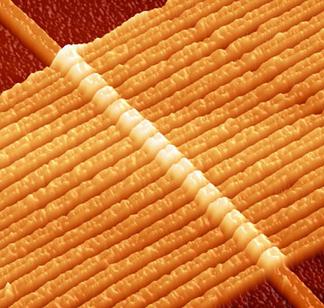Memristor
Memristor
Since the dawn of electronics, we've had only three types of circuit components--resistors, inductors, and capacitors. But in 1971, UC Berkeley researcher Leon Chua theorized the possibility of a fourth type of component, one that would be able to measure the flow of electric current: the memristor. Now, just 37 years later, Hewlett-Packard has built one.

What is it? As its name implies, the memristor can "remember" how much current has passed through it. And by alternating the amount of current that passes through it, a memristor can also become a one-element circuit component with unique properties. Most notably, it can save its electronic state even when the current is turned off, making it a great candidate to replace today's flash memory.
Memristors will theoretically be cheaper and far faster than flash memory, and allow far greater memory densities. They could also replace RAM chips as we know them, so that, after you turn off your computer, it will remember exactly what it was doing when you turn it back on, and return to work instantly. This lowering of cost and consolidating of components may lead to affordable, solid-state computers that fit in your pocket and run many times faster than today's PCs.
Someday the memristor could spawn a whole new type of computer, thanks to its ability to remember a range of electrical states rather than the simplistic "on" and "off" states that today's digital processors recognize. By working with a dynamic range of data states in an analog mode, memristor-based computers could be capable of far more complex tasks than just shuttling ones and zeroes around.
When is it coming? Researchers say that no real barrier prevents implementing the memristor in circuitry immediately. But it's up to the business side to push products through to commercial reality. Memristors made to replace flash memory (at a lower cost and lower power consumption) will likely appear first; HP's goal is to offer them by 2012. Beyond that, memristors will likely replace both DRAM and hard disks in the 2014-to-2016 time frame. As for memristor-based analog computers, that step may take 20-plus years.
time line for lost 3 year
- 2010
- (February 2) The 2nd Memristor and Memristive Systems Symposium was held on Tuesday, February 2, 2010 at Sutardja Dai Hall, UC Berkeley.
- (February 17) A review on memristor and its modeling approaches was accepted by the Proceedings of the Royal Society.
- (April 20) Memristor-based Content Addressable Memory (MCAM) was introduced and accepted in IEEE Transactions on Very Large Scale Integration (VLSI) Systems.
- (June 1) At the 2010 International Symposium on Circuits and Systems, there were two special sessions on memristor devices and fabrication. Mouttet's talk "The mythology of the memristor" argued that the interpretation of the memristor as a fourth fundamental was incorrect and that the device discovered by HPLabs was not actually a memristor, but part of a broader class of memristive systems.
- (August 31) HP announced they had teamed up with Hynix to produce a commercial product dubbed "ReRam".
- (October 15) At the 2010 IEEE Nanotechnology Materials and Devices Conference, Delgado presented "The Memristor as Controller". This work introduced the memristor as a programmable gain for closed loop systems and derived an approximate describing function for the pinched hysteresis loop.
- (December 7) Ju-Hee So and Hyung-Jun Koo of North Carolina State University announced a hydrogel form of memristor which was speculated to be useful to construct a brain-computer interface.
- 2011
- (Oct) Researchers at Palo Alto Research Center (PARC) demonstrated printed memristive counters based on solution processing, with potential applications as low-cost packaging components (no battery needed; powered by energy scavenging mechanism).
- 2012
- (March 23) A team of researchers from HRL Laboratories and the University of Michigan announced the first functioning memristor array built on a CMOS chip for applications in neuromorphic computer architectures.
- (July 31) Severe criticism of the generalized memristor concept in the publication "Fundamental Issues and Problems in the Realization of Memristors".
- 2013
- (February 27) Senior lecturer Dr. Andy Thomas and his colleagues from Bielefeld University construct a memristor that is capable of learning. The group utilize memristors as key components in a blueprint for an artificial brain. The results are presented in the March print edition of the Journal of Physics published by the Institute of Physics in London.
- (April 23) A group of the Jülich Aachen Research Alliance including researches from RWTH Aachen University and Forschungszentrum Jülich argument in an article in Nature Communications that the current memristive theory must be extended to a whole new theory to properly describe redox-based resistively switching elements (ReRAM). The main reason is the existence of nanobatteries in redox-based resistive switches which violates the memristor theory's requirement for a pinched hysteresis.







0 comments: